#palo mayombe
Text

Mama Shola’s shrine.
5 notes
·
View notes
Text
Spirits and their common uses and misconceptions
The Congo Spirit
This better known spirit is well known through the Espiritismo community, but also through other spiritual communities like, Umbanda, Palo Mayombe, Santeria, Sanse, 21 divisions and Haitian Vudu. Let's start off with some history, The republic of Congo inhabits so many diverse religious communities and this wasn't any different before colonialism, much of their spiritual practices were tied to animism, vitalism, herbalism, witchcraft, ancestral and spirit veneration and sorcery. Some commonly known congo spirits are Tata/Papa Francisco, Negro, Tata Jose, Papa Guinea, Candelo, Felipe, to name a few. Many of these spirits were once living and were commonly known as witch doctors, paleros, root workers, and juju men. They faced enslavement during colonialism due to their religious/spiritual practices being deemed as devil worship through Christianity and many had to hide their beliefs through syncretism to Christian saints. It's commonly misconceived that these spirits are rageful and angry spirits, yet that is far from the truth they can be playful, wise, gentle and foolish. They love to play tricks and hide items around in the house, but not to enrage one, but to teach one patience and care. Many were enslaved so they do tend to protect their kin and those they walk with, with great strength. They are able to remove spiritual ailments, witchcraft, evil eye, espiritus oscuros (dark spirits), and negative energy off a practicioner. They can be offered liquor, tobacco, black coffee, candy, candle light, sharpened stones and water. These are spirits of light, but they also are able to teach great offensive magic. They can usually be housed in a rock and stick found through a trip to the mountains or woods. You would offer the spirit of the forest or mountain an offering for these gifts and customize them to what the spirit guides you to do. Usually a libation (a drink poured out to honor and give thanks to a particular spirit) is presented through this process as well as 21 pennies washed and prayed over with a cigar broken into half. You could also offer some popcorn and some pennies and it will suffice, if you're running short on some dough. The rock and stick must be consecrated with smoke and liquor. Many of these spirits had their own spiritual beliefs so they might pull you to learn about their belief system and even get intiated to appease the spirit. Also some of them tend to be in service of a greater Deity, Loa, and/or Orisha. SEDIFE! They resonate with the number 3 and 7. The colors white, black and red can also be used to represent them.
Prayer to El Congo
O Glorious Congo Spirit, for your virtues you have entered into the Kingdom of God and have obtained the blessings of Heaven. You leader of the heavenly commission of spirits and surrounded by Angels. I an admirer of your strength and courage, knowledge and wisdom, ask in the name of the Father, Son and Holy Spirit that you fill my body with your powers and aid me in vanquishing the evil thoughts sent by my enemies. Liberate me O Congo spirit from the snare of the Devil, and the demons that surround him. Vanquish from me all evil spirits and bind their hands and feet, may they never reach me, shut their mouths so they may never speak to or on me. O Glorious spirit of the Congo, with you at my side I shall defeat all my enemies and with your strength I shall overcome all obstacles and opposition. With your sublime powers given to you by God, I ask that you aid me in my daily necessities. Guard my home against envy, hate, jealousy, bad luck, witchcraft and all that is evil. Free me from all negative forces. I light this candle in your honor, and ask that you illuminate my path. As it is, So it is done. AMEN!
youtube
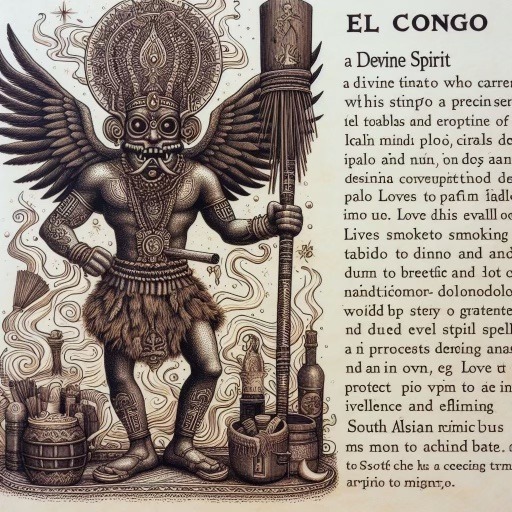
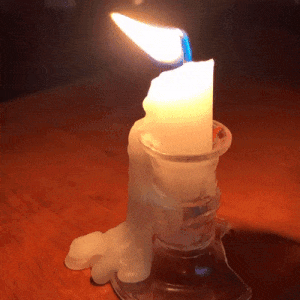
#brujo#espiritismo#magic#magus#palo mayombe#palo#congo#congo spirit#spiritualism#spirits#colonialism#witches#sanse#candelo#sedife#ATR#diaspora#diasporic#religion#faith#prayer#spells#folk magic#santeria#republic of congo#animism#rituals#magick#Youtube
2 notes
·
View notes
Text
So it's been a while since I've watched videos about ATRs on youtube, and let me just say, it's full of even more garbage than before.
This was not necessarily the case about five years ago--Yes, there were frauds and garbage documentaries about African religions, but you could also find good documentaries and legitimate ceremonies on that platform if you searched a little. Not now, apparently. I don't know what happened within the past five years, but the influencers have somehow gotten a hold of tatas, santeros, macumbeiros, and pais de santo and are wreaking absolute havoc.
Is it the algorithm? Is it because tiktok found African Religion? Is it because of the pandemic?
I legitimately don't know, but good luck finding any reliable information there. There are still legitimate sources on Haitian Vodou, but with any other Afrolatino ATR, all bets are off. It's sad, actually--Anyone who wants to connect with any of these religions in a credible way should be able to, and modern technology should act as a facilitator for that rather than a hindrance. But, with a long sigh, I say that I guess it's just the world we live in now. Absolute hellscape
0 notes
Text
Do I have actual thing I need to read and study for school? Yes, Yes I do. Am I gonna waste time reading up on some obscure thing in history that does not affect my academic standing at all? Also Yes.
1 note
·
View note
Text
Folk horror seems to be an attempt to "correct" racism and otherism in horror and then you see a film categorized as that that engages in racism and otherism.
4 notes
·
View notes
Text
Translated from Onyx Path Forums
Seré extremadamente franco cuando diga esto:
Las Guadanas se basan muy claramente en el culto a Adolfo Constanzo, hasta en la incorrecta atribución de sacrificios de sangre/humanos a la Santa Muerte, cuando la religión en cuestión era Palo Mayombe. Son un cártel criminal que rinde culto a La Santa, que es una figura religiosa que ya ha sido mal utilizada numerosas veces por individuos en diversos medios. El hecho de que los autores sepan que la Santa Muerte se remonta a los "cultos aztecas a la muerte" (que es una forma extremadamente... insulsa de decir que la Santa Muerte es una tradición largamente practicada que se ha transmitido de generación en generación) indica que hay capacidad de investigación. En particular, el clavo en el ataúd aquí es que Las Guadanas son un cártel de drogas adorador de la Santa Muerte. No creo que sea necesario explicar cuál es el problema aquí.
Sudamérica se ha utilizado constantemente a lo largo de la historia de CoD/WoD como "misterioso santuario criminal del malvado culto a la muerte", a falta de un término mejor. Ver esto de nuevo, ver una fe semiclandestina tan deliberadamente tergiversada, y ver a la gente tan inmediatamente ansiosa por utilizar este contenido del juego es extremadamente desconcertante. Si quieres tener un pacto basado en la creencia de la Santa Muerte, está bien, pero... como que debería haber sido investigado, y realmente, REALMENTE no debería haber involucrado a los cárteles, especialmente porque esto está MUY claramente basado en un culto REAL de la vida real que ha > causado que la Santa Muerte tenga una mala reputación.
Se vuelve realmente viejo ver, una y otra vez, a México / el Sur Global usado como una zona de "OOOH SPOOKY SCARY OOOH CULTS OOOH BLOOD SACRIFICE". Hay mucho más que eso, y el hecho de que estos conceptos racistas no se comenten y se celebren no me gusta.
Las Guadanas podrían muy fácilmente ser un grupo supremamente interesante, jugando con los aspectos positivos de La Santa, y las visiones positivas de la Muerte en general.
No creo que estaría tan frustrado si fuera por el hecho de que los autores saben que Ella ha sido transmitida de generación en generación por estos "cultos aztecas a la muerte" (como se ha dicho con tanto entusiasmo), lo que significa que alguien buscó en Google La Santa, buscó la fe, miró todo lo demás, y ... decidió ir con el retrato que continúa el uso de la línea México/Sudamérica como zona neurálgica para sacrificios de sangre, criminales y asesinatos.
En fin, espero que Las Guadanas cambie cuando se amplíe. Se hace muy, muy viejo, ver lo mismo de siempre una y otra vez.
EDITO PARA AÑADIR: En realidad también estoy irritado porque SÉ que Onyx Path investiga. Scion trabaja con individuos nativos para retratar respetuosamente las creencias en cuestión y las culturas implicadas. SÉ que OP se esfuerza por no repetir estos viejos estereotipos ofensivos con otras líneas. Entonces, ¿sólo está bien cuando se trata de México? Sé que Hunter y Scion son equipos de escritura diferentes, pero hay algo que me molesta.
También tengo que dejar muy claro que parte de mi problema se debe a la forma en que se ha tratado a Sudamérica en el canon. Aunque hay algunos ejemplos positivos, la MAYORÍA del contenido es... así.
Original post (in English)

36 notes
·
View notes
Photo

The Satanic Beheading of Mark Kilroy
Heading into March of 1989, Mark Kilroy was a pretty average 21-year old college student at the University of Texas. For Spring Break he and some of his friends decided to make an adventure out of it. This year, they decided to go big, and vacation along the Texas-Mexico border in an area called South Padre Island.
For the first couple of nights, they decided to stick close to the place they were staying, enjoying themselves along the beach and at nearby bars. But that Sunday, they decided to cross the U.S.-Mexico border, and visit some foreign soil for an evening. They had such a good time, in fact, that they decided to do the same thing the following night - March 13th, 1989. Several hours later, as everyone began stumbling back home - intoxicated, no doubt - Mark's friends realized that he wasn't anywhere to be found. In the parade of college students crossing the border, heading back to flophouses and rental homes, he had gotten separated from his friends. The following morning, Mark failed to show up or call any of them, and he was reported missing to local police.
Mark Kilroy seemed to have disappeared straight into thin air. His case struggled to gain any headway but then Mark's case was featured on "America's Most Wanted," where it gained international recognition, but his case would remain rudderless... until the following month.
On April 1st, 1989, south of the Mexican border, a vehicle blew through a routine traffic checkpoint. Police followed the vehicle to its destination: a ranch house out in Santa Elena. Police detained the driver, and conducted a compulsory search of the home. There, they found a large amount of narcotics... as well as items which, they believed, were occult in-nature.
About a week later, police returned to the ranch house, and conducted a more thorough scan. They believed the home might have been used for drug dealing, and arrested everyone that was present: not only the people living on the property, but farm workers as well.
While questioning everyone involved, a farmhand confessed that he had seen the missing college student on the ranch - a young man he later identified as Mark Kilroy. Obviously, this intrigued investigators, who had grown perplexed over the disappearance of the American college student.
Further interrogations yielded even more answers. Albeit, terrifying answers.
One of the other people that law enforcement had detained told investigators that they were part of a drug-dealing cult, which had sacrificed Mark Kilroy during one of their rituals. He was one of their most recent victims, but he most definitely wasn't their first.
The cult, this detainee claimed, was led by a young man named Adolfo Constanzo.
Constanzo was just 26 years old: a charismatic young man that his followers had nicknamed "The Godfather." He had grown up in a mixed religious household, with one parent practicing Catholicism and the other, voodoo. Because of this, he had grown up with a warped sense of religion, which continued to evolve during his adolescence.
When he began dealing drugs, Constanzo began to incorporate his skewed religious beliefs, which derived heavily from Palo Mayombe - a religion that utilizes sacrificial offerings. Constanzo and his followers began making animal sacrifices to increase their luck... but as time went on, and their business dealings got bigger and bigger, they decided that bigger risks were necessary.
About a year before the death of Mark Kilroy, this group had purchased a home out in Santa Elena, and began sacrificing humans. At first, they targeted victims who wouldn't be missed -primarily, the homeless and nameless - but then the decision was made to go after someone with a "good" brain, as some followers would later describe.
An American; in particular, a good-looking, educated American. Mark Kilroy.
Mark had been singled out by Constanzo and his followers as he walked towards the border. They pulled up in a truck and asked him if he wanted a ride home; and when he got close enough, two men jumped out and threw him into the vehicle. Kilroy, because of his size and athleticism, was actually able to break free and escape... but another vehicle was waiting to stop him and complete the kidnapping.
Taking 21-year old Mark Kilroy back to the ranch house, Constanzo and his followers proceeded to torture and dismember the young man for several hours. You can look up the details online, but... to save you the misery, let me just say that it was rough. Approximately twelve hours after being detained, Mark Kilroy was killed by Constanzo via machete; and several of his body parts were then harvested to complete the ritual.
After his death, Mark Kilroy's remains were disposed of, and buried along the fifteen or so other victims that Constanzo and his followers had sacrificed in the preceding months.
Adolfo Constanzo and a handful of his followers managed to elude capture for several weeks, having been betrayed by some of their own following the drug bust at their ranch home. But the next month - May of 1989 - found the rest of the group cornered in a Mexico City apartment. Constanzo prepared to go out shooting, but quickly ran out of ammunition and cowardly asked one of his followers to shoot him. His follower obliged, ending Adolfo Constanzo's life before he could face justice.
The remaining members of Constanzo's group were arrested, charged, and eventually convicted for the murder of Mark Kilroy (among others). Some have since passed away, while others remain behind bars.
The death of Mark Kilroy remains a tragic example of religion-gone-awry: spiritual beliefs distorted by eager psychopaths. And, for many that bought into the Satanic Panic scare of the 1980's, it might have even felt like vindication: proof that their worst fears were becoming a reality.
Despite the family and loved ones of Mark Kilroy receiving answers, they had to learn the horrible truth about Mark's final hours... hours marked by pain and misery. However, at least they were able to give the young man's story some closure, and were able to rest easy knowing that the offenders would not hurt anyone else's son, brother, and friend.
For other victims, those answers - and that closure - simply don't exist.
73 notes
·
View notes
Text

The Satanic Beheading of Mark Kilroy
Heading into March of 1989, Mark Kilroy was a pretty average 21-year old college student at the University of Texas. For Spring Break he and some of his friends decided to make an adventure out of it. This year, they decided to go big, and vacation along the Texas-Mexico border in an area called South Padre Island.
For the first couple of nights, they decided to stick close to the place they were staying, enjoying themselves along the beach and at nearby bars. But that Sunday, they decided to cross the U.S.-Mexico border, and visit some foreign soil for an evening. They had such a good time, in fact, that they decided to do the same thing the following night - March 13th, 1989. Several hours later, as everyone began stumbling back home - intoxicated, no doubt - Mark’s friends realized that he wasn’t anywhere to be found. In the parade of college students crossing the border, heading back to flophouses and rental homes, he had gotten separated from his friends. The following morning, Mark failed to show up or call any of them, and he was reported missing to local police.
Mark Kilroy seemed to have disappeared straight into thin air. His case struggled to gain any headway but then Mark’s case was featured on “America’s Most Wanted,” where it gained international recognition, but his case would remain rudderless… until the following month.
On April 1st, 1989, south of the Mexican border, a vehicle blew through a routine traffic checkpoint. Police followed the vehicle to its destination: a ranch house out in Santa Elena. Police detained the driver, and conducted a compulsory search of the home. There, they found a large amount of narcotics… as well as items which, they believed, were occult in-nature.
About a week later, police returned to the ranch house, and conducted a more thorough scan. They believed the home might have been used for drug dealing, and arrested everyone that was present: not only the people living on the property, but farm workers as well.
While questioning everyone involved, a farmhand confessed that he had seen the missing college student on the ranch - a young man he later identified as Mark Kilroy. Obviously, this intrigued investigators, who had grown perplexed over the disappearance of the American college student.
Further interrogations yielded even more answers. Albeit, terrifying answers.
One of the other people that law enforcement had detained told investigators that they were part of a drug-dealing cult, which had sacrificed Mark Kilroy during one of their rituals. He was one of their most recent victims, but he most definitely wasn’t their first.
The cult, this detainee claimed, was led by a young man named Adolfo Constanzo.
Constanzo was just 26 years old: a charismatic young man that his followers had nicknamed “The Godfather.” He had grown up in a mixed religious household, with one parent practicing Catholicism and the other, voodoo. Because of this, he had grown up with a warped sense of religion, which continued to evolve during his adolescence.
When he began dealing drugs, Constanzo began to incorporate his skewed religious beliefs, which derived heavily from Palo Mayombe - a religion that utilizes sacrificial offerings. Constanzo and his followers began making animal sacrifices to increase their luck… but as time went on, and their business dealings got bigger and bigger, they decided that bigger risks were necessary.
About a year before the death of Mark Kilroy, this group had purchased a home out in Santa Elena, and began sacrificing humans. At first, they targeted victims who wouldn’t be missed -primarily, the homeless and nameless - but then the decision was made to go after someone with a “good” brain, as some followers would later describe.
An American; in particular, a good-looking, educated American. Mark Kilroy.
Mark had been singled out by Constanzo and his followers as he walked towards the border. They pulled up in a truck and asked him if he wanted a ride home; and when he got close enough, two men jumped out and threw him into the vehicle. Kilroy, because of his size and athleticism, was actually able to break free and escape… but another vehicle was waiting to stop him and complete the kidnapping.
Taking 21-year old Mark Kilroy back to the ranch house, Constanzo and his followers proceeded to torture and dismember the young man for several hours. You can look up the details online, but… to save you the misery, let me just say that it was rough. Approximately twelve hours after being detained, Mark Kilroy was killed by Constanzo via machete; and several of his body parts were then harvested to complete the ritual.
After his death, Mark Kilroy’s remains were disposed of, and buried along the fifteen or so other victims that Constanzo and his followers had sacrificed in the preceding months.
Adolfo Constanzo and a handful of his followers managed to elude capture for several weeks, having been betrayed by some of their own following the drug bust at their ranch home. But the next month - May of 1989 - found the rest of the group cornered in a Mexico City apartment. Constanzo prepared to go out shooting, but quickly ran out of ammunition and cowardly asked one of his followers to shoot him. His follower obliged, ending Adolfo Constanzo’s life before he could face justice.
The remaining members of Constanzo’s group were arrested, charged, and eventually convicted for the murder of Mark Kilroy (among others). Some have since passed away, while others remain behind bars.
The death of Mark Kilroy remains a tragic example of religion-gone-awry: spiritual beliefs distorted by eager psychopaths. And, for many that bought into the Satanic Panic scare of the 1980’s, it might have even felt like vindication: proof that their worst fears were becoming a reality.
Despite the family and loved ones of Mark Kilroy receiving answers, they had to learn the horrible truth about Mark’s final hours… hours marked by pain and misery. However, at least they were able to give the young man’s story some closure, and were able to rest easy knowing that the offenders would not hurt anyone else’s son, brother, and friend.
For other victims, those answers - and that closure - simply don’t exist.
14 notes
·
View notes
Text
What Is The Real Crossroads
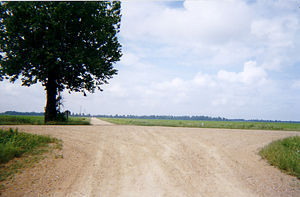
The crossroads or the “forks of the road” is a place where two roads meet.
The crossroads is the land that belongs to no one, a place outside the borders, which is a good place to perform traditional African magical rituals whether that be Hoodoo or Vodou etc. Like the cemetery, and the railroads the crossroads has its own spirit. The crossroads may also serve as an altar where offerings can be laid out. There crossroads in the hoodoo tradition: the performance of the crossroads ritual to gain skill and to perform magical spells.
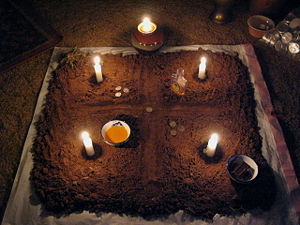
(ancestral work and offering using graveyard dirt in a crossroads pattern.)this can also be used for contacting spirits and dividation)
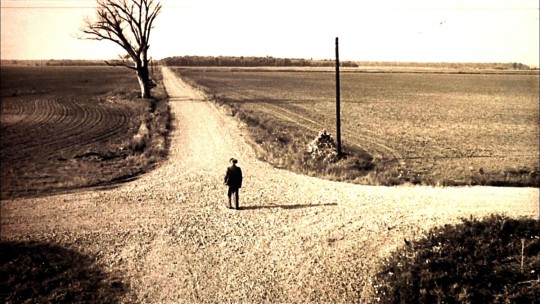
(This is the place where the famous guitar player call up the devil)
Working for Clients Using The Crossroads:
A root doctor or conjure worker may go down to the crossroads for clients to help them dispose of ongoing negative situations and conditions in their lives. Hoodoo root workers also call upon the spirits of the crossroads on behalf of their clients, gather crossroads stones or dirt for spell work.
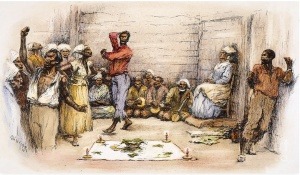
(1885 pic showing a Hoodoo dance in Louisiana using a portable crossroads.)
The Portable Crossroads:
Not all rituals that use the crossroads need to take place at an actual crossroads. When doing magic some hoodoo practitioners use what is known as a “portable crossroads” or a circle with a cross inside, also called an “X” or “cross-mark”. This portable crossroads can be drawn on the ground with a stick or on an altar with sachet powders. It may be painted on a wall or laid out on a blanket.

(A home and altar of a African Diaspora religion with a crossroads painted on the wall.)
Other Cultures Using The Crossroads:
Many of the spirits and deities from the African Traditional and African Diasporic religions are associated with the crossroads. In Lukumi / Santeria, the orisha associated with the crossroads is Eleggua.
In the Louisiana Voodoo tradition or Palo Mayombe, there are several lwa associated with the crossroads including Papa Legba and Met Carrefour. In India, the Hindu deities associated with the crossroads are Ganesha, the opener of the way, and Bhairava, an aspect of Shiva who protects the boundaries. Catholic Tradition the Catholic Church Saint, Saint Peter, is associated with the crossroads showing the crossed keys of heaven. Saint Expedite is also associated with the crossroads.
The crossroads is a spiritual Nexus, a place to help or to get help. It's Powerful.

The Kongo cosmogram or "Yowa" cross represents the human life cycle of death and rebirth of the soul. In this cycle, a body of water flows between the physical realm and the spiritual realm. Kongo water spirits, (Sim'bi) are believed to have the ability to travel between the two realms. The Yowa cross is the origins of the Hoodoo crossroads.
Last do not disposed your trash at a crossroads it is disrespectful to the spirits there, I mean would you want someone to dump there trash at your place. 🤔 Think about it ..
#Crossroads#Hoodoo#Voodoo#Spiritual#Southern#Louisiana#Spirit#Traditional#Sim'bi spirits#Hoodoo cross roads#like and/or reblog!#like and subscribe#google search results#ask me anything#Crossroads spirit's#follow my blog#reblog post
40 notes
·
View notes
Text

0 notes
Text
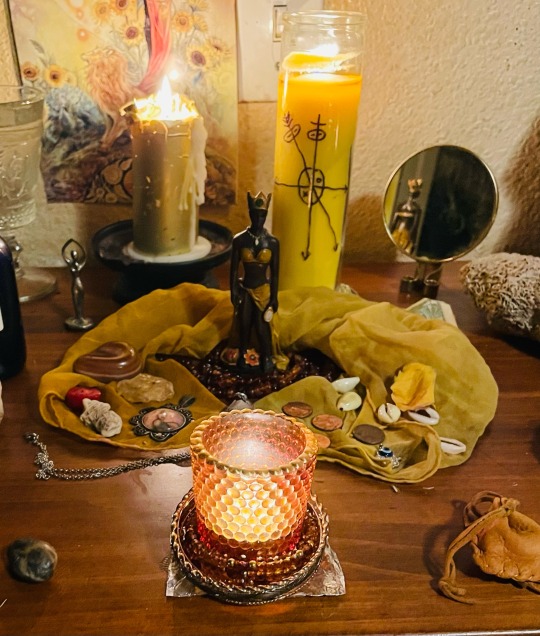
Mama Shola Wengue.
5 notes
·
View notes
Text
La ceremonia de la Nkimba, conocida como "Rayamiento", es la iniciación al culto del Palo Mayombe. No todos pueden ser iniciados, ya que depende de la aprobación de la Nganga. Antes de acudir a un Tata, se realiza una consulta para determinar si debe ser rayada o no. Es importante tener en cuenta que las consecuencias de una iniciación incorrecta son negativas, ya que no es compatible con las fuerzas del Palo Mayombe. Si es necesario, el primer paso es convertirse en Nguello bajo la protección del padrino y la tutela del fundamento. Algunos Munanzos dan una Mpaka o un Lucero en este paso, pero el primer paso no debe ser convertirse en Tata o Yaya. El Ngueyo se presenta a los poderes para su evolución y protección, convirtiéndose en Nguello del Munanso. Debe pasar por un proceso de adiestramiento por parte del padrino para aprender sobre la religión y su interrelación. El Nguello no posee fundamento ni puede manejar ceremonias importantes. Cuando el Tata y la Nganga consideran que está listo, se Juramenta como Tata o Yaya, y adquiere la potestad para realizar juramentos y ceremoniales propios del rango religioso en el Mayombe. Es importante respetar el proceso y no saltar pasos para evitar problemas. Mi intención no es crear discordia ni debates, sino guiar correctamente a todos en nuestras tradiciones.

4 notes
·
View notes
Quote
Originally, the word “bozal” meant “savage” or “untamed horse,” ultimately referring to the Portuguese and Castilian spoken by black African slaves. The “bozal” is also a muzzle: the device employed to censure, silence, and tame humans’ words and to also prevent animals from barking and biting. As David Wheat points out, the term is comparable to chapetón, a Spanish-American word that referred to rosy-cheeked Iberians newly arrived in the Americas.[118] But Africans labeled as “bozles” were not merely inexperienced greenhorns; they were viewed as newcomers to the Iberian world in general, unacquainted with its social and cultural practices.[119] As the category’s use rapidly declined on the Iberian Peninsula, due to shrinking black populations, the term did, however, continue to circulate in the Anglophone slave vernacular and Spanish Caribbean colonies—primarily in Cuba—well into the twentieth century, circulating in Blackface teatro bufo performances and private religious celebratory gatherings called cajón de muerto from the Congolese-centered Palo Mayombe religious-spiritual traditions. My reading of bozal embodies a somatic-linguistic relationship. The prolix lexicographer Covarrubias defines “bozal” as “el negro que no sabe otra lengua que la suya; y la lengua, o lenguaje se llama labio, y los labios bezos; de boca, boza, y de allí bozal”[120] (The black who knows no other tongue than his own. The tongue, or language, derives its name from the lips, and big lips come from “boca” to “boza,” from which we get “bozal”). Covarrubias’s entry reveals Habsburg Spain’s somatic and cultural fixation on big African lips. The trope of big (African) lips recurs in countless sixteenth- and seventeenth-century Spanish archival, poetic, prosaic, and theatrical works. Therefore, Covarrubias’s etymological treatment of the word “bozal” fixates on bodily excess, the grotesque, the scatological, and the uncanny, each functioning as metadiscourses that further characterize literary authors’ renditions of habla de negros linguistic embodiment on the written page.(pg. 80-81)
Nicholas R. Jones - Staging Habla de Negros: Radical Performances of the African Diaspora in Early Modern Spain (2019)
3 notes
·
View notes
Note
Had a theoretical Maniac Cop 4 been made with Robert Z'Dar, what would have liked to have seen it?
I think it maybe would've been interesting for other officers who had been wronged in one way or another to gravitate towards Matt and him basically having a sort of cult type thing could've been interesting. Like less so a religious one and more so them putting him in a leadership position and maybe he semi accepts this because there is sort of trauma bonding. I still stand by my idea of basically wanting to make the horror movie version of Magnum Force in a way. XD
Speaking of religion, I would've loved to see an expansion on the use of Palo Mayombe with regard to Matt's nature and the question of whether someone could potentially control him because getting dead spirits to do stuff for you is a major element of that faith. The third film at times treats the faith as if it's voodoo despite the fact that voodoo and Palo Mayombe have vast differences. For all intents and purposes, Palo Mayombe has practices that most people would consider necromancy and there's all kinds of possibility that comes with that.
3 notes
·
View notes
Text
Eternal Life Spell (1)
In modern Western magical traditions, only Palo Mayombe acknowledges the use of human bones. This was once not unusual however. Despite all the Halloween skeletal imagery, few today have actually seen exposed, bare human bones. Once upon a time this was not so unusual (and the practices still survives amongst some isolated traditions). Bodies were disinterred for various reasons having nothing to do with vandalism.
Certain traditions disinter ancestors periodically to invite them to rituals and celebrations, returning them to the grave at the conclusion
Other traditions retain ancestral bones to honor and communicate with them
Particularly in areas where land is scarce, bodies may only remain underground as long as flesh remains. Bones are permanently moved to catacombs or ossuaries
Bones are also disinterred so that magical rituals can take place to preserve the deceased’s soul for eternity or to activate the reincarnation process.
Paint human bones red to magically provide the deceased with eternal life, of one sort or another. Menstrual blood was the most ancient activation material; however red ochre has also been used since prehistoric times.
(from The Element Encyclopedia of 5,000 Spells by Judika Illes)
9 notes
·
View notes
